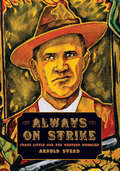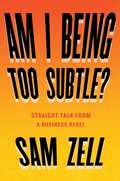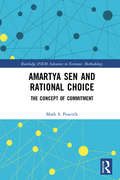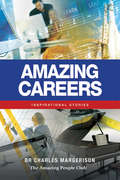- Table View
- List View
Always on Strike
by Arnold SteadThough widely recognized as one of the Industrial Workers of the World's leading members and one of its most prominent militants, this is the first book-length biography of Frank Little. Little's life offers innumerable lessons for working class people facing many of the same economic injustices in today's world. Arnold Stead, PhD, is a poet, fiction writer, historian, playwright, and jazz and film critic. He lives in Minneapolis, Minnesota, with his wife and family.
Always-On Business: Aligning Enterprise Strategies and IT in the Digital Age (Progress in IS)
by Nijaz Bajgorić Lejla Turulja Amra AlagićModern business relies heavily on information technology. This book presents a new “always-on” business model for the digital age, one based on three interrelated components: a business model, an IT capability model, and an always-on information system model. In addition, it develops an implementation framework for the new model by identifying business-critical continuous computing information technologies as implementation drivers.The model proposed in this book reveals the critical role of business continuity management in ensuring business continuity even when operations are unaffected by any disasters. Using empirical survey data, PLS-SEM (Partial Least Squares - Structural Equation Modeling) combined with mediation analysis are used to test the model and hypotheses.The book is chiefly intended for students in Business Administration/Management degree programs and business leaders whose work involves addressing issues such as organizational performance, IT capability, enterprise information systems, IT management, business continuity management, disaster recovery management, risk management, IT auditing, and compliance.
Am I Being Too Subtle?: Straight Talk From a Business Rebel
by Sam ZellThe traits that make Sam Zell one of the world’s most successful entrepreneurs also make him one of the most surprising, enigmatic, and entertaining mavericks in American business. Self-made billionaire Sam Zell consistently sees what others don’t. From finding a market for overpriced Playboy magazines among his junior high classmates, to buying real estate on the cheap after a market crash, to investing in often unglamorous industries with long-term value, Zell acts boldly on supply and demand trends to grab the first-mover advantage. And he can find opportunity virtually anywhere—from an arcane piece of legislation to a desert meeting in Abu Dhabi. “If everyone is going left, look right,” Zell often says. To him, conventional wisdom is nothing but a reference point. Year after year, deal after deal, he shuts out the noise of the crowd, gathers as much information as possible, then trusts his own instincts. He credits much of his independent thinking to his parents, who were Jewish refugees from World War II. Talk to any two people and you might get wild swings in their descriptions of Zell. A media firestorm ensued when the Tribune Company went into bankruptcy a year after he agreed to steward the enterprise. At the same time, his razor-sharp instincts are legendary on Wall Street, and he has sponsored over a dozen IPOs. He’s known as the Grave Dancer for his strategy of targeting troubled assets, yet he’s created thousands of jobs. Within his own organization, he has an inordinate number of employees at every level who are fiercely loyal and have worked for him for decades. Zell’s got a big personality; he is often contrarian, blunt, and irreverent, and always curious and hardworking. This is the guy who started wearing jeans to work in the 1960s, when offices were a sea of gray suits. He’s the guy who told The Wall Street Journal in 1985, “If it ain’t fun, we don’t do it.” He rides motorcycles with his friends, the Zell’s Angels, around the world and he keeps ducks on the deck outside his office. As he writes: “I simply don’t buy into many of the made-up rules of social convention. The bottom line is: If you’re really good at what you do, you have the freedom to be who you really are.” Am I Being Too Subtle?—a reference to Zell’s favorite way to underscore a point—takes readers on a ride across his business terrain, sharing with honesty and humor stories of the times he got it right, when he didn’t, and most important, what he learned in the process. This is an indispensable guide for the next generation of disrupters, entrepreneurs, and investors.
Am I Enough?: Embracing the Truth About Who You Are
by Grace Elaine ValentineHave you had enough?Young women today are constantly told they are not enough for this world—not pretty enough, not smart enough, not exciting enough, not spiritual enough, and just plain not good enough. The barrage is constant. The consequences are real. The damage often feels permanent.As a young woman herself, Grace Valentine has felt the pressure of trying to survive in a toxic culture, let alone thrive. But she’s had enough. With an engaging combination of honesty and humor, Grace uses her story to confront the lies the world tells us every day—lies such as:You are beautiful because a guy told you so,Love must be earned,You should forget your past,You will never be enough, and more.Am I Enough? is a line in the sand. It’s a declaration that we will never be enough for this world because we were not created for this world. Instead, Grace reminds us that we were created by Someone better for something better. We can choose the One who has chosen us—the One who says: “You are enough for Me, My child. Come as you are.”
Am I Making Myself Clear?: Secrets of the World's Greatest Communicators
by Terry FelberIn Am I Making Myself Clear?, business leader and author Terry Felber shares the secrets of the world's greatest communicators, equipping readers to do everything from participating in a meaningful conversation to successfully consummating a business discussion. Through ten essential skills, including such concepts as the Art of Unspoken Language, the Art of Encouragement, and the Art of Problem Solving, he shows readers how to achieve real communication. With its practical and easy-to-follow insights, Am I Making Myself Clear? is an invaluable resource for managers, couples, and parents seeking to improve their personal and professional relationships and chart a course for success."Good communication is the foundation of all healthy relationships. Am I Making Myself Clear? examines this subject in a simple and articulate fashion. This in-depth study is important reading for everyone who wants to enrich their family, social, and business interactions." ?Ron Puryear, Worldwide Group"Am I Making Myself Clear? defines in a clear and concise way the elements that are key to successful communication. The illustrations and 'power points' in the text create an easy-to-read classic on this subject." ?Bill Britt, Trinity Motivation
AmTran Technology Ltd.
by Willy Shih Jyun-Cheng Wang Karen RobinsonAs an original design manufacturer (ODM) of television sets and leading supplier to Vizio, a market leader in the U.S. for LCD flat panel TVs, AmTran Technology Ltd. uses what founder Alpha Wu describes as a "WE" model in which western companies perform sales, marketing, and product definition work, while eastern companies in Asia like his perform the engineering and manufacturing work. Confronted with commoditization pressure, Wu is presented with the opportunity to license a major TV brand. Is this consistent with his model? The case explores the changes that have taken place in the consumer television receiver market and the challenges faced by leaders of the analog market like Sony. It is intended for use with the technical note, "Competency-destroying Technology Transitions: Why the Transition to Digital is Particularly Challenging," HBS No. 613-024.
Amagansett Funds (A)
by Andrew McafeeAmagansett Funds has had a troubled history with its customer relationship management (CRM) system. Sales agents feel that they derive no value from it and that it is a "tax on their jobs." Amagansett is investigating whether CRM can be improved by making its data available wirelessly to Blackberry devices. These devices will also provide mobile phone and e-mail capability.
Amalita: La biografía
by Soledad Vallejos Marina AbiusoBiografía de Amalia Lacroze de Fortabat, la mujer más rica de laArgentina. Una historia de política, dinero y amor llena de datos sorprendentes. «No habrá ninguna igual», así la despidieron las mujeres de su familia cuando murió, en febrero de 2012. La mujer más rica de la Argentina, la viuda convertida en empresaria cementera de la noche a la mañana, fue tan poco común como su historia. Amalia Lacroze de Fortabat podía ponerse al frente de su propio equipo de fútbol profesional con la misma naturalidad con la que mandaba en la compañía cementera que había heredado de su marido, almorzaba con presidentes (democráticos o no) o se hacía retratar por Andy Warhol. Hija de una familia patricia, con mucho prestigio social pero no tanta fortuna económica, era una veinteañera casada con un abogado cuando conoció a Alfredo Fortabat, el industrial -también casado- capaz de sacar millones de las piedras. Divorciados, en segundas nupcias formaron un matrimonio donde los negocios, el amor y la política fueron de la mano. Tras enviudar, Amalita hizo de sí misma una leyenda, sin importar si la verdad sufría en el camino. De su mano, Loma Negra creció aunque se sucedieran los gobiernos. Hubo contratiempos: un juicio millonario por estafa al Estado y la investigación por la desaparición de un abogado en 1977. Prestó su avión para la guerra y ayudó a los ex combatientes de Malvinas, desarrolló una fuerte tarea de acción social con su fundación y se concedió todos los caprichos: una radio, un diario, los hombres que quiso. Amalita es el resultado de una intensa y rigurosa investigación periodística. Es el producto de haber entrevistado a quienes la conocieron y trataron en los más diversos ámbitos, pero también de una obsesiva tarea de archivo. Marina Abiuso y Soledad Vallejos han escrito una maravillosa biografía repleta de secretos; como su protagonista, una mujer que sorprendió hasta en su último acto: vender la empresa que la hizo famosa. En su final, conservó el dinero, no el poder.
Aman Resorts
by Aldo Sesia Eugene SoltesAman Resorts describes the operating model and philosophy of this high-end set of global properties. Aman relies on employees taking considerable initiative to deliver the highest quality personalized service in the hospitality industry. The case also highlights Aman's strategy and operations which differ in many ways from industry standards.
Aman Resorts (B)
by Aldo Sesia Eugene SoltesAman Resorts (B) describes how employees are rewarded and compensated which is used to supplement Aman Resorts (A).
Amanco: Developing the Sustainability Scorecard
by Robert S. Kaplan Ricardo Reisen de PinhoDescribes the challenges of using the Balanced Scorecard to implement a triple-bottom-line strategy for delivering excellent economic, environmental, and social performance. The owners and senior executive team of Amanco, a producer of plastic pipe and complete water treatment systems, want strong financial returns but are also deeply committed to improving the environment and making a difference in people's lives. Robert Salas, CEO, wants a management system that communicates and motivates Amanco's three high-level goals. Initially, he creates a simple scorecard of measures, but he soon migrates to developing a strategy map and Balanced Scorecard that places economic, environmental, and social objectives as the highest-level objectives. He faces the challenges of cascading the corporate Balanced Scorecard to operating units throughout Latin America and how to develop better measures of social and environmental impact. Salas must also address whether he can sustain Amanco's balanced strategy while entering the Brazilian market, where he faces an entrenched and much larger competitor.
Amanda and Kristen: Mented Cosmetics
by Steven Rogers Alterrell MillsCase - The case highlights the two co-founders (black HBS alumnae) of a black-owned beauty startup and the unmet needs within the beauty industry. This case study examines the entrepreneurial opportunities that come from identifying an underserved market, specifically within the black community. Students learn approaches to product ideation/innovation, marketing strategies for the social media age and launching a startup for a targeted audience. Students learn to analyze macro and micro economic data of an industry, synthesize consumer demographics and purchase behavior data, and create pro forma financial documents to determine the potential economic opportunity that is unmet in a market and the requisite fundraising to launch a new business. Mented co-founders became the 15th and 16th African-American women to raise over $1 million in startup funding.
Amandla Capital: Real Estate in C te d'Ivoire
by John D. Macomber Pippa Tubman Armerding Dilyana BothaThis case describes Amandla Capital, a fledgling company in Cote d'Ivoire, facing three opportunities in the real estate and hospitality industries in Africa. It introduces students to several concepts: decision making and cost-benefit analysis in real estate, corporate strategy selection, management of stakeholders with varied needs and levels of sophistication, dealing with conflicts of interest, basics of hospitality and hotel management industries.
Amartya Sen
by Christopher W. MorrisAmartya Sen was awarded the Nobel Memorial Prize in Economics in 1998 "for his contributions in welfare economics." Although his primary academic appointments have been mostly in economics, Sen is also an important and influential social theorist and philosopher. His work on social choice theory is seminal, and his writings on poverty, famine, and development, as well his contributions to moral and political philosophy, are important and influential. Sen's views about the nature and primacy of liberty also make him a major contemporary liberal thinker. This volume of essays on aspects of Sen's work is aimed at a broad audience of readers interested in social theory, political philosophy, ethics, public policy, welfare economics, the theory of rational choice, poverty, and development. Written by a team of well-known experts, each chapter provides an overview of Sen's work in a particular area and a critical assessment of his contributions to the field.
Amartya Sen and Rational Choice: The Concept of Commitment (Routledge INEM Advances in Economic Methodology)
by Mark S. PeacockAre human beings motivated exclusively by self-interest? The orthodox theory of rational choice in economics thinks that they are. Amartya Sen disagrees, and his concept commitment is central to his vision of an alternative to mainstream rational choice theory. This book examines commitment as it has evolved in Sen's critique of orthodox rational choice theory. The in-depth focus on commitment reveals subtleties in the concept itself as well as in its relationships with other concepts which Sen develops in his critique of rational choice theory, for example preference, sympathy, weakness of will, agency, personhood, social norms, rights, self-welfare goal and self-goal choice. The book provides a comprehensive understanding of commitment and offers novel interpretations of the term as a way of strengthening its plausibility. Broadly in support of Sen’s conceptualization of rational choice, the book nevertheless reveals ambiguities and weaknesses in Sen’s conceptual framework, and it reformulates Sen’s concepts when doing so strengthens the claims he makes. The book also engages with critics of Sen and argues for the importance of commitment as a component in the theory of rational choice.
Amateurs without Borders: The Aspirations and Limits of Global Compassion
by Allison SchnableAmateurs without Borders examines the rise of new actors in the international development world: volunteer-driven grassroots international nongovernmental organizations. These small aid organizations, now ten thousand strong, sidestep the world of professionalized development aid by launching projects built around personal relationships and the skills of volunteers. This book draws on fieldwork in the United States and Africa, web data, and IRS records to offer the first large-scale systematic study of these groups. Amateurs without Borders investigates the aspirations and limits of personal compassion on a global scale.
Amazing Business People - A Short eBook
by Charles MargerisonBusiness makes the world go round. This unique audio collection from The Amazing People Club explores the lives of four amazing people who all enjoyed global success in a variety of ways. Get an insight into the life of Henry Ford, the man behind one of the biggest car brands in the world. Born on a farm, Henry's journey took him to Detroit, where he built the first mass produced vehicles - the Model T, the Model A and the system of 'Fordism'. His talent for invention and machines was inspired by other amazing individuals, including Thomas Edison. Also meet Beulah Henry, called 'Lady Edison' by many; she was a prolific inventor. Many people have actually never heard of her despite her development of over 101 inventions! Be amazed by Henry Bessemer who played a critical role in steel making and steam engines which drove the industrial revolution and find out about George de Mestral whose ingenuity was responsible for Velcro, now used all over the world. It's a great example of the fact that behind every invention, there is an amazing story! Each story comes to life through BioViews®. These are short biographical narratives, similar to interviews. They provide an easy way of learning about amazing people who made major contributions and changed our world.
Amazing Careers: Inspirational Stories
by Charles MargerisonHow did Charles Darwin, Albert Einstein and Coco Chanel choose their careers? Discover how these and other high achievers became successful in Amazing Careers. In life, the work we do often determines our status in society as much as the money we earn. Some people choose their job because of strong convictions while others are motivated by salary. This book provides a unique insight into lives of people who had exciting and interesting careers and can help provide inspiration to you in your own. Each amazing career is explored through BioViews® which are short biographical stories, similar to interviews. These unique stories provide an easy way of learning about amazing people who made major contributions and changed our world.
Amazing Decisions: The Illustrated Guide to Improving Business Deals and Family Meals
by Dan ArielyDan Ariely, the New York Times bestselling author of Predictably Irrational, and illustrator Matt R. Trower present a playful graphic novel guide to better decision-making, based on the author’s groundbreaking research in behavioral economics, neuroscience, and psychology. The internationally renowned author Dan Ariely is known for his incisive investigations into the messy business of decision-making. Now, in Amazing Decisions, his unique perspective—informed by behavioral economics, neuroscience, and psychology—comes alive in the graphic form. The illustrator Matt R. Trower’s playful and expressive artwork captures the lessons of Ariely’s groundbreaking research as they explore the essential question: How can we make better decisions?Amazing Decisions follows the narrator, Adam, as he faces the daily barrage of choices and deliberations. He juggles two overlapping—and often contradictory—sets of norms: social norms and market norms. These norms inform our thinking in ways we often don’t notice, just as Adam is shadowed by the “market fairy” and the “social fairy,” each compelling him to act in certain ways. Good decision-making, Ariely argues, requires us to identify and evaluate the forces at play under different circumstances, leading to an optimal outcome. Amazing Decisions is a fascinating and entertaining guide to developing skills that will prove invaluable in personal and professional life.
Amazing Entrepreneurs: Inspirational Stories
by Charles MargerisonWere the people who developed successful businesses lucky or did they have special talents? In Amazing Entrepreneurs, new from The Amazing People Club, you can explore these questions through the lives of some of the world's most famous entrepreneurs and perhaps be inspired to do likewise! Helena Rubinstein was lucky to find a sponsor for her skin care business but it was her vision and tenacity that ensured her success. Ray Kroc's entrepreneurial talents enabled him to grow McDonalds from a local burger joint into an international phenomenon. The life stories and achievements of characters including Thomas Edison, Madam C. J. Walker, Henry Ford, Walt Disney, Beulah Henry and William Boeing come alive in a unique way through BioViewsâ. A BioView® is a short biographical story, similar to an interview. These unique stories provide an easy way of learning about amazing people who made major contributions and changed our world. These are inspirational stories that can help you achieve your ambitions in your journey through life.
Amazing Millionaires - A Short eBook
by Charles MargerisonYou may know the names of famous millionaires and wonder how they struck it rich. This unique collection of short audio stories from The Amazing People Club tells their tales. It explores the lives of four amazing millionaires and follows them on their amazing journeys to fame and fortune. Meet Cesar Ritz, the man behind the term 'Ritzy', whose life was just that. He came to be known as the 'king of hoteliers, and hotelier to kings'. Also, meet the man behind the Nobel Prizes. Alfred Nobel's life, often shrouded in mystery, comes to life through his BioViews® as we explore his career as a chemist, engineer, innovator, and armaments manufacturer. Unknown to many people, he actually invented dynamite! Meet Howard Hughes - aviator, engineer, industrialist, film producer, film director and philanthropist who became who became one of the wealthiest people in the world. Another fascinating character is Henry Wellcome. He may have saved your life with the medicines he produced. The Wellcome Trust is one of the largest medical charities in the world. Each story is unique and amazing and could perhaps be just what you need for inspiration to achieve your own ambitions. Each story comes to life through BioViews®. These are short biographical narratives, similar to interviews. They provide an easy way of learning about amazing people who made major contributions and changed our world.
Amazing Things Will Happen
by C. C. ChapmanWork hard, be kind, and amazing things will happenAmazing Things Will Happen offers straightforward advice that can be put into action to improve your life. Through personal anecdotes from the author's life, and interviews of successful individuals across several industries, this book demonstrates how to achieve success, in all aspects of life, through hard work and acts of kindness. Split into five sections, this book details how to begin the self-improvement journey.Explains how to cope with the situation you are currently in, and how to make the most of it until you can break freeShares exercises and practices that can help define your goals and how to set realistic tasks to reach themHelps you to navigate the seas of doubters and obstacles to get to where you want to beEnsures that you help others, once you have reached your goalsEach of us has different goals in life, but everyone wants to succeed, and have as much fun as possible along the way. Amazing Things Will Happen shows how to get on this path to success.
Amazing Women: Inspirational Stories
by Charles MargerisonWho was the first woman to qualify as a doctor? Who is the only woman to have won two Nobel Prizes? Explore these and other amazing stories in Amazing Women. In this unique story collection from The Amazing People Club, the real lives of iconic women including Coco Chanel, Sojourner Truth, Maria Montessori, Eva Peron and Helen Keller come to life. Understand their real lives and challenges and be inspired by what they did and how they achieved it. This is a must-read for every woman seeking inspiration. Meet some of the world's most amazing women through BioViews. ~~~ A BioView- is a short biographical story, similar to an interview. These unique stories provide an easy way of learning about amazing people who made major contributions to our world and can help you achieve your ambitions in your journey through life.
Amazon Ads sin gastar un céntimo (Auto-publicación sin gastar un céntimo #5)
by Prasenjeet KumarDebemos admitir que Amazon Ads es absolutamente la última plataforma de publicidad para comercializar sus libros en Amazon. Punto. Desafortunadamente, existen demasiadas formas en las que usted se puede equivocar al tratar de aprovechar el tremendo potencial de esta bestia. Adicionalmente, la experiencia es enlodada por una gran cantidad de malos consejos que circulan por internet, los cuales hacen que toda esta aventura con Amazon Ads sea una experiencia frustrante, exasperante y absolutamente costosa. Entonces, ¿De qué manera se equivocan los autores? En mi opinión: Primero que nada, al establecer una puja muy alta que les hace gastar demasiado dinero sin lograr buenos resultados y, por ejemplo, obtener un Retorno sobre la Inversión (ROI) negativo. Segundo, al estresarse demasiado acerca de una perfecta descripción de las ventas, por probar diferentes descripciones, o por hacer ambos. Tercero, al sobre monitorear sus anuncios. Las soluciones son sencillas, y este libro va a recortar el sobrante para enseñarle estrategias que realmente funcionen. Entonces, prepárese para aprender como: * Configurar sus anuncios; * Segmentar su audiencia (incluyendo en otros territorios fuera de los Estados Unidos, acerca de los cuales ningún otro libro les enseña); * Entender las pujas y los reportes de las ventas; * Chequear la ganancia de sus anuncios (sin sumergirse bajo un bombardeo de lenguaje técnico); * Escribir las descripciones de sus anuncios (un proceso que la mayoría de los libros hace parecer muy complicado), y mucho más… Todo esto, por supuesto, “¡Sin gastar un céntimo (casi)!”
Amazon Buys Whole Foods
by David Lane Jose B. Alvarez Joni CoughlinThe June 2017 news that e-commerce giant Amazon was paying $13.7 billion for organic supermarket chain Whole Foods precipitated a broad sell-off in the shares of grocery retailers and suppliers. Behind the precipitous declines lay recognition that Amazon's bold move into brick and mortar assets offered transformational opportunities. Amazon could gain expertise in perishable product sales and procurement, plus access to 30 million well-off shoppers and 463 grocery stores in key U.S. markets. Whole Foods could absorb Amazon's technology and process expertise to modernize and reduce its operating costs, which were among the highest in the industry. For grocery retailers and suppliers, the deal portended increased competitive pressures in a saturated market. As 2018 dawned, all parties were assessing the deal's implications. Had the stock market overreacted to news of the deal? Why was Amazon buying Whole Foods? What were the long-term implications of the deal for the food value chain?

















